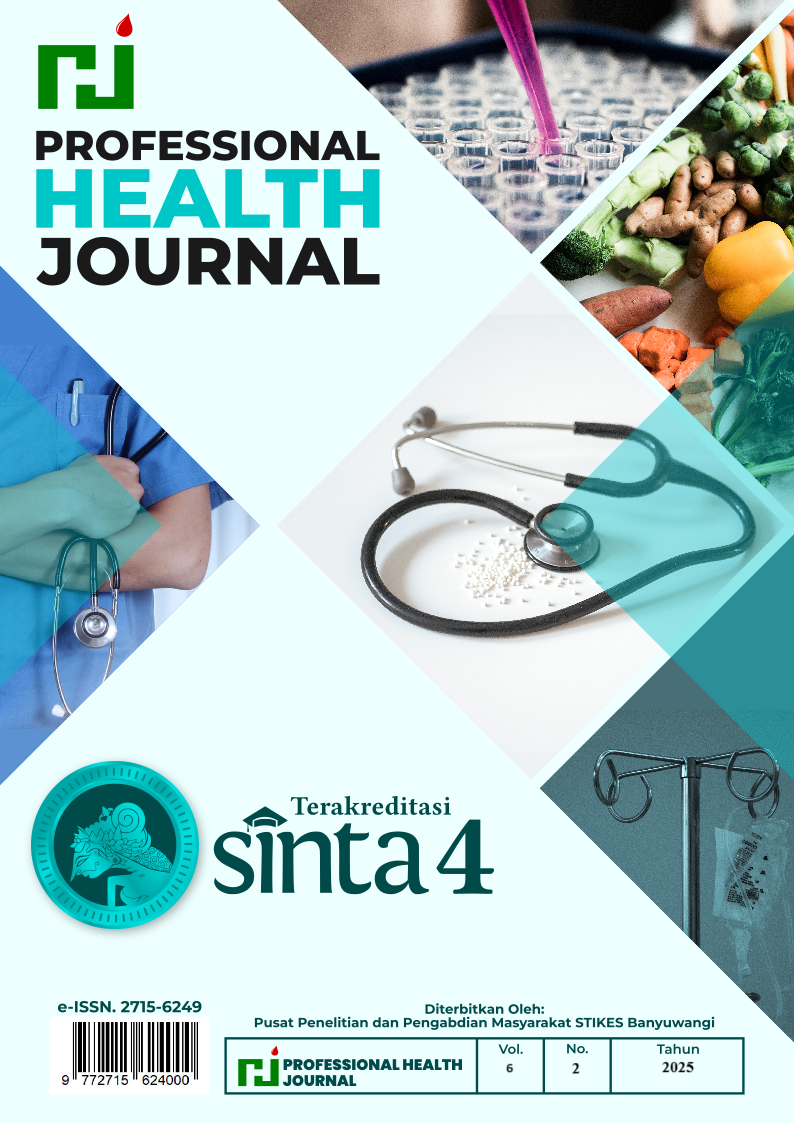Effectiveness of the Nareswari Method (Breathing, Relaxation, and Coloring) on Reducing Anxiety Levels in Postpartum Mothers"
DOI:
https://doi.org/10.54832/phj.v6i2.868Keywords:
hypnobreastfeeding, coloring therapy, postpartum anxiety, postpartum blues, relaxationAbstract
Background: The postpartum period is a period of adaptation that is quite difficult for a mother. Various complaints can arise during the postpartum period, both physical and psychological complaints. Postpartum hormonal changes and adaptation to a new role as a mother often cause mothers to experience changes in mood, and become easily sad and sensitive. These symptoms are usually called postpartum blues. The still high rate of postpartum blues in the world, namely 70-80%, and the rate of postpartum blues in Indonesia, namely 60-70%, shows that the mental health problems of postpartum mothers require special attention. The results of a preliminary study at the Mrican Community Health Center, Kediri City, showed that 70% of 52 postpartum mothers (36 respondents) experienced anxiety during the postpartum period. In Indonesia, postpartum blues is still considered normal and does not require special treatment, even though this problem has a high impact on the welfare of postpartum mothers and their babies.
Objectives: The aim of this research is to determine the effectiveness of the Nareswari method (Breathing, Relaxation, and Coloring) in reducing the anxiety level of postpartum mothers as an effort to prevent cases of postpartum blues. The Nareswari method is a combination of hypnobreastfeeding techniques and coloring therapy (coloring).
Methods: This type of research is observational analytical experimental research with a case-control approach with two group pretest and post-test. The independent variables are hypnobreastfeeding and coloring hypnosis. The dependent variable is the level of anxiety of postpartum mothers and the number of samples in this study was 50 respondents.
Results: The results of statistical tests show a significant difference between the level of anxiety in the treatment group and the control group (p-value = 0.0000 < α value 0.05).
Conclusions: The Nareswari method is effective in reducing anxiety levels in postpartum mothers. There was a significant reduction in anxiety levels after postpartum mothers routinely used this method for one month.
Downloads
References
Asih, Y., & Nyimas, A. (2020). Hypnobreastfeeding to increase motivation and breast milk production: A study. International Journal of Innovation, Creativity and Change, 13(2), 122–137.
Dağlı, E., & Aktaş Reyhan, F. (2024). The effect of online hypno-breastfeeding and solution-focused psychoeducation on mothers’ breastfeeding motivation and perception of insufficient milk: Randomize controlled study. Health Care for Women International, 45(7), 796–810. https://doi.org/10.1080/07399332.2023.2244903
Hal, F., Vereswati, H., Nawangsih, S. K., & Sari, D. P. (2024). Metode Mewarnai Untuk Menurunkan Stres dan Kecemasan Pada Pendamping Pasien ( Caregiver ). Jurnal Abdimas Budi Darma. 4(2), 64–76.
Hanum, P., Ritonga, A. R., Pratiwi, D. P., Wati, L., Ningsih, R. W., & Serianti. (2021). Pengaruh Teknik Hypnobreastfeeding Terhadap Pengeluaran Asi Pada Ibu Nifas. Jurnal Ilmiah Kebidanan Imelda, 7(1), 36–41. https://doi.org/10.52943/jikebi.v7i1.524
Kharisma Virgian. (2022). Literature Review: Happy Breastfeeding With Hypno Breastfeeding. International Journal Scientific and Professional (IJ-ChiProf), 1(2), 104–109. https://doi.org/10.56988/chiprof.v1i2.16
Marwiyah, N., Suwardiman, D., Mutia, H. K., Alkarimah, N. A., Rahayu, R., Nuraeni, N., & Uzzakiyyah, I. (2022). Faktor Determinan yang Mempengaruhi terjadinya Postpartum Blues pada Ibu Nifas. Faletehan Health Journal, 9(01), 89–99. https://doi.org/10.33746/fhj.v9i01.298
Qiftiyah, M. (2018). Studi Tingkat Kecemasan Ibu Post Partum Terhadap Kelancaran ASI Pada Ibu Nifas Hari Ke-5 (Di BPM Asri Dan Polindes Permata BundaTuban). LPPM AKES Rajekwesi Bojonegoro, 8(2), 39–43.
Riyanti, E., Pudjiati, P., Hidayat, E., Prayetni, P., & Nurdahlia, N. (2023). Terapi Seni (Mewarnai dan Menggambar) Membantu Lansia Mengatasi Kecemasan. Jkep, 8(2), 252–260. https://doi.org/10.32668/jkep.v8i2.1349
Sandriani, S., Fitriani, R., & Rahayu, G. Z. (2023). Effect of Oxytocin Massage on Breast Milk Production in Postpartum Mothers: A Case Study. Genius Midwifery Journal, 2(1), 30–38. https://doi.org/10.56359/genmj.v2i1.237
Sulistia. (2024). Pengetahuan Ibu Hamil Tentang Baby Blues Syndrome Understanding of Pregnant Women About Baby Blues. JIM FKep, VIII(1), 7. https://jim.usk.ac.id/FKep/article/viewFile/24054/12239
Tarisa, N., Octarianingsih, F., Ladyani, F., & Pramesti, W. (2020). Distribusi Frekuensi Kejadian Postpartum Blues Pada Ibu Pascamelahirkan. Jurnal Ilmiah Kesehatan Sandi Husada, 12(2), 1057–1062. https://doi.org/10.35816/jiskh.v12i2.430
Trianasari, G., Putri, M. R., & Eltrikanawati, T. (2024). Pengaruh Hypnobreastfeeding terhadap Peningkatan Produksi ASI pada Ibu Nifas di TPMB Atlantika Kota Batam Tahun 2023. Healthcaring: Jurnal Ilmiah Kesehatan, 3(1), 10–17. https://doi.org/10.47709/healthcaring.v3i1.3262
Widyawati, M. N. (2017). The Effect of Hypnobreastfeeding and Oxytocin Massage on Breastmilk. Authors JMSCR Vol. 05. Issue.10. Page 28600-28604

















